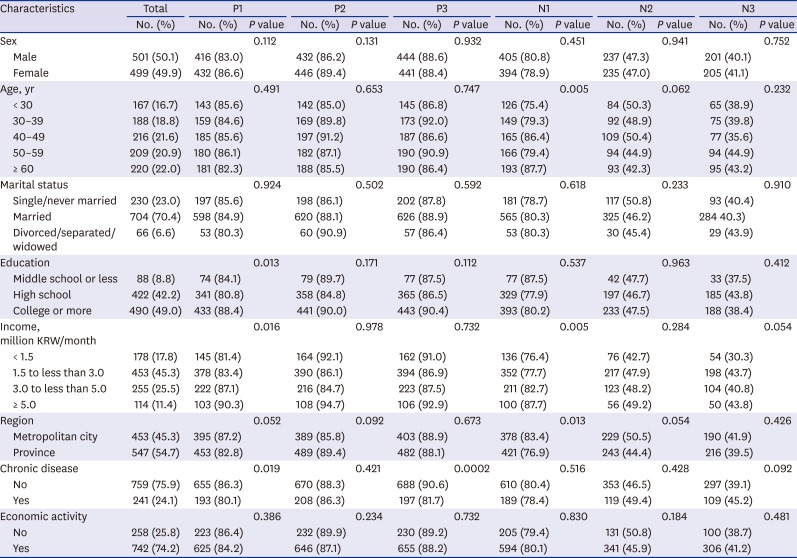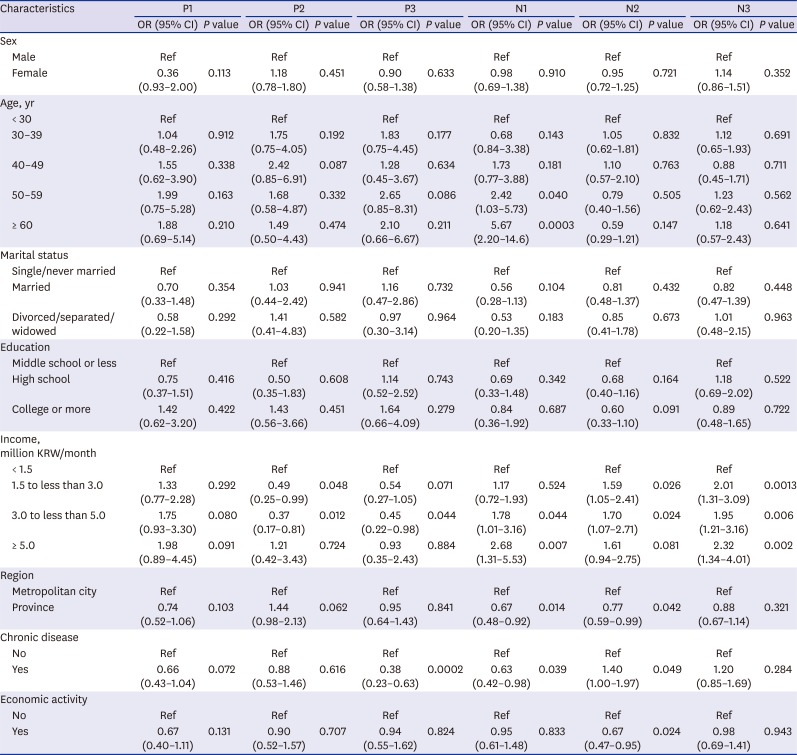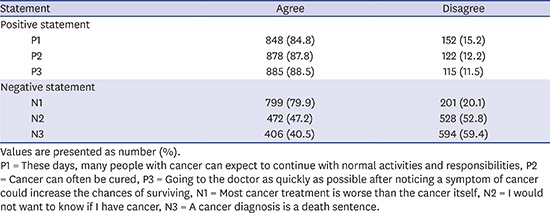1. Purandare L. Attitudes to cancer may create a barrier to communication between the patient and caregiver. Eur J Cancer Care (Engl). 1997; 6(2):92–99. PMID:
9233159.
2. Ramírez AS, Rutten LJ, Oh A, Vengoechea BL, Moser RP, Vanderpool RC, et al. Perceptions of cancer controllability and cancer risk knowledge: the moderating role of race, ethnicity, and acculturation. J Cancer Educ. 2013; 28(2):254–261. PMID:
23355279.
3. Niederdeppe J, Levy AG. Fatalistic beliefs about cancer prevention and three prevention behaviors. Cancer Epidemiol Biomarkers Prev. 2007; 16(5):998–1003. PMID:
17507628.
4. Beeken RJ, Simon AE, von Wagner C, Whitaker KL, Wardle J. Cancer fatalism: deterring early presentation and increasing social inequalities? Cancer Epidemiol Biomarkers Prev. 2011; 20(10):2127–2131. PMID:
21876191.
5. McCutchan GM, Wood F, Edwards A, Richards R, Brain KE. Influences of cancer symptom knowledge, beliefs and barriers on cancer symptom presentation in relation to socioeconomic deprivation: a systematic review. BMC Cancer. 2015; 15(1):1000. PMID:
26698112.
6. Robb KA, Power E, Atkin W, Wardle J. Ethnic differences in participation in flexible sigmoidoscopy screening in the UK. J Med Screen. 2008; 15(3):130–136. PMID:
18927095.
7. Vrinten C, Waller J, von Wagner C, Wardle J. Cancer fear: facilitator and deterrent to participation in colorectal cancer screening. Cancer Epidemiol Biomarkers Prev. 2015; 24(2):400–405. PMID:
25634890.
8. Hiom SC. Diagnosing cancer earlier: reviewing the evidence for improving cancer survival. Br J Cancer. 2015; 112(Suppl 1):S1–S5. PMID:
25734391.
9. Dein S. Explanatory models of and attitudes towards cancer in different cultures. Lancet Oncol. 2004; 5(2):119–124. PMID:
14761816.
10. Vrinten C, Wardle J, Marlow LA. Cancer fear and fatalism among ethnic minority women in the United Kingdom. Br J Cancer. 2016; 114(5):597–604. PMID:
26867159.
11. Bergamo C, Lin JJ, Smith C, Lurslurchachai L, Halm EA, Powell CA, et al. Evaluating beliefs associated with late-stage lung cancer presentation in minorities. J Thorac Oncol. 2013; 8(1):12–18. PMID:
23207921.
12. Quaife SL, Winstanley K, Robb KA, Simon AE, Ramirez AJ, Forbes LJ, et al. Socioeconomic inequalities in attitudes towards cancer: an international cancer benchmarking partnership study. Eur J Cancer Prev. 2015; 24(3):253–260. PMID:
25734238.
13. McPhail S, Johnson S, Greenberg D, Peake M, Rous B. Stage at diagnosis and early mortality from cancer in England. Br J Cancer. 2015; 112(Suppl 1):S108–S115. PMID:
25734389.
14. Lee K, Lim HT, Hwang SS, Chae DW, Park SM. Socio-economic disparities in behavioural risk factors for cancer and use of cancer screening services in Korean adults aged 30 years and older: the Third Korean National Health and Nutrition Examination Survey, 2005 (KNHANES III). Public Health. 2010; 124(12):698–704. PMID:
20888016.
15. Choi YJ, Jeong BG, Cho SI, Jung-Choi K, Jang SN, Kang M, et al. A review on socioeconomic position indicators in health inequality research. J Prev Med Public Health. 2007; 40(6):475–486. PMID:
18063903.
16. Lee M, Park EC, Chang HS, Kwon JA, Yoo KB, Kim TH. Socioeconomic disparity in cervical cancer screening among Korean women: 1998–2010. BMC Public Health. 2013; 13(1):553. PMID:
23742100.
17. Cho J, Smith K, Choi EK, Kim IR, Chang YJ, Park HY, et al. Public attitudes toward cancer and cancer patients: a national survey in Korea. Psychooncology. 2013; 22(3):605–613. PMID:
22344743.
18. Miller M, Kearney N, Smith K. Measurement of cancer attitudes: a review. Eur J Oncol Nurs. 2000; 4(4):233–245. PMID:
12849020.
19. Simon AE, Forbes LJ, Boniface D, Warburton F, Brain KE, Dessaix A, et al. An international measure of awareness and beliefs about cancer: development and testing of the ABC. BMJ Open. 2012; 2(6):e001758.
20. Keeney S, McKenna H, Fleming P, McIlfatrick S. Attitudes to cancer and cancer prevention: what do people aged 35-54 years think? Eur J Cancer Care (Engl). 2010; 19(6):769–777. PMID:
19708946.
21. Kim HK, Lwin MO. Cultural effects on cancer prevention behaviors: fatalistic cancer beliefs and risk optimism among Asians in Singapore. Health Commun. 2017; 32(10):1201–1209. PMID:
27613075.
22. Robb KA, Simon AE, Miles A, Wardle J. Public perceptions of cancer: a qualitative study of the balance of positive and negative beliefs. BMJ Open. 2014; 4(7):e005434.
23. Cheng H, Sit JW, Twinn SF, Cheng KK, Thorne S. Coping with breast cancer survivorship in Chinese women: the role of fatalism or fatalistic voluntarism. Cancer Nurs. 2013; 36(3):236–244. PMID:
22964870.
24. Shin DC, Rutkowski CP, Park CM. The Quality of Life in Korea: Comparative and Dynamic Perspectives. Dordrecht: Kluwer Academic Publishers;2003.
25. Schapira MM, Davids SL, McAuliffe TL, Nattinger AB. Agreement between scales in the measurement of breast cancer risk perceptions. Risk Anal. 2004; 24(3):665–673. PMID:
15209937.
26. Kim MS, Kim SW, Shin SB. Attitudes towards social risks in Korea. Health Welf Policy Forum. 2014; 210:49–64.
27. Befort CA, Nazir N, Engelman K, Choi W. Fatalistic cancer beliefs and information sources among rural and urban adults in the USA. J Cancer Educ. 2013; 28(3):521–526. PMID:
23813489.







 PDF
PDF Citation
Citation Print
Print




 XML Download
XML Download